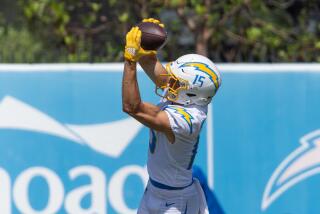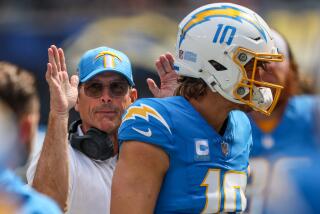McCallum Is Making His Charge
SAN DIEGO â Sunday was to be a big afternoon for Napoleon McCallum. It was Military Day at Jack Murphy Stadium. The turnout of uniformed men, in this military town, was heavy. And when McCallum, a Navy man, caught a two-yard pass in the fourth quarter of the San Diego Chargersâ pre-season game against the Cowboys, an ovation was the result.
It was the first football game for McCallum since December 1986, the end of his rookie year with the Los Angeles Raiders. And for this return to action, McCallum was grateful, but not overjoyed. That measly two-yard reception was the start of his new career as a Charger, but it also was his only play the entire game.
New coach Dan Henning had planned for McCallum to play more, but much of the running game was scrapped when the Chargers fell way behind early. âI was hoping to play a lot more,â McCallum said, âbut (Henning) said things didnât go as he expected. We were behind, and Iâm not in the passing game as much.â
Still, McCallum has dealt with much larger disappointments than this and he is characteristically upbeat about shaking off the layers of rust formed from two years of football inactivity.
He also hopes he can help the Chargers out of the doldrums as he takes on the new job of Navy recruiter that apparently will allow him to play football while he is serving the remainder of his five-year commitment to the Navy. âThis is a Navy town, a lot of the Chargers fans are military people and I feel this is going to be just great,â he said.
To recap a bit, McCallum -- the leading rusher in Naval Academy history -- was drafted by the Raiders in the fourth round of 1986. John Lehman, secretary of the Navy at the time, allowed McCallum to play for the Raiders while being stationed on the USS Peleliu, in Long Beach. Despite rigorous duties, he commuted to the Raiders and rushed for 536 yards as a rookie.
But the following spring, new secretary James Webb, who had other ideas about what uniform a Navy man should be wearing, interrupted McCallumâs career by sending him to the USS California. Commuting was out, since the California, a guided-missile cruiser based near Oakland, would be on duty in the Pacific and Indian oceans during the football season.
In fact while the California was somewhere near the Philippines, his wife Karen sent a telegram that began, âHi Honey. Youâve been traded to the San Diego Chargers.â
William Ball, the man who succeeded Webb, and the Navy brass approved McCallumâs request to work as a recruiter in San Diego and play for the Chargers in his âoff-duty hours,â as long as football doesnât conflict with his Navy duties.
McCallum -- committed to the Navy until the end of 1990 -- will end his current leave at the end of pre-season training camp, begin recruiting work at the San Diego Navy Recruiting District, Naval Training Center, Point Loma.
McCallum has been saying for years, ever since his undergraduate days, that he and highly visible officer-athletes such as David Robinson and former running back Eddie Myers could demonstrate great value to the Navy by being full-time recruiters while playing professionally. âBut at the time when the decision was made not to do it,â he said, âthose people (in charge) had different goals and objectives. ... Iâm just real happy to be able to do this again, and so soon.â
There were certainly a lot of times when McCallum wondered about whether he would get the chance before the five years was up, and whether he should even wait it out. Many days McCallum would run around the ship as part of his workout and shipmates would cheer, knowing how much he appreciated the support. But other days McCallum said he would ask himself: âWhy am I going through all this? Whatâs the point?â
Few if any of the crew members on the California doubted McCallum would endure, the way he pushed himself to make it work that season with the Raiders. They knew he had to be close to exhaustion all the time from working two jobs and commuting a minimum of two hours a day. They admired the way he pushed himself to stay in NFL shape when he didnât know whether there was an NFL future.
Now that the future is here, itâs also complicated. At McCallumâs position, which the Chargers simply call ârunning back,â seven players are listed on the depth chart. That does not include Gary Anderson, last seasonâs rushing leader, who is a contract holdout. So McCallum is one of eight players competing for playing time, not to mention a limited number of roster spots.
But one thing could be working in McCallumâs favor, something over which he has no control. McCallum came to the Chargers with tackle John Clay in exchange for Jim Lachey (now of the Washington Redskins) in a trade for which Chargers director of operations Steve Ortmayer has taken criticism. While Lachey has been to the Pro Bowl and is a Redskins starter, Clay (who had been previously injured) has been waived. McCallum not making the team would make the trade a disaster for the Chargers.
McCallum, just recovering from a hamstring injury, knows he is a player who thrives on a heavy workload. âAt the academy,â he said, âI got a lot of repetition and carries. The more reps I got, the better. In this situation, youâre under pressure because you donât have the luxury of getting a lot of reps. In a pre-season game or a scrimmage, you might get one chance -- as I did today -- and thatâs it.


